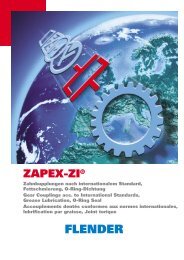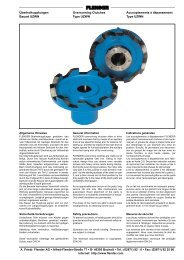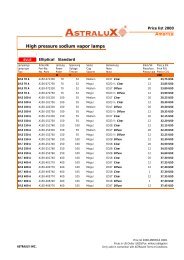fluid couplings - Laumayer
fluid couplings - Laumayer
fluid couplings - Laumayer
Create successful ePaper yourself
Turn your PDF publications into a flip-book with our unique Google optimized e-Paper software.
STANDARD OR REVERSE MOUNTING<br />
11. INSTALLATION<br />
11.1 STANDARD MOUNTING<br />
Driver inner impeller<br />
Minimum possible inertia is added to the motor, that is therefore<br />
free to accelerate more quickly.<br />
During the starting phase, the outer impeller gradually reaches<br />
the steady running condition. For very long starting times, heat<br />
dissipation capacity is lower.<br />
If a braking system is required, it is convenient and easy to<br />
install a brake drum or disc on the flex coupling.<br />
For the very few cases in which the driven machine cannot be<br />
rotated by hand, maintenance procedures of oil checking and<br />
refilling, as well as alignment, become more difficult.<br />
The delayed fill chamber, when present, is fitted on the driven<br />
side. The rotating speed of the said chamber gradually increases<br />
during start-up, thus leading to a longer starting time, given the<br />
bleed orifices diameters are not changed. If oil quantity is<br />
excessively reduced, the transmissible torque may be lower<br />
than the starting torque of the driven machine. In such a case,<br />
part of the oil remains inside the delayed chamber. This lack of oil<br />
in the <strong>fluid</strong> coupling may prevent starting the <strong>fluid</strong> coupling up.<br />
The “switching pin” device might not work correctly on<br />
machines where, owing to irregular operating conditions, the<br />
driven side may suddenly stop, or jam during the starting phase.<br />
Flex coupling is protected by the presence of the <strong>fluid</strong> coupling in<br />
front of it, and therefore this configuration is fit for applications<br />
with frequent start-ups or inversions of the rotating sense.<br />
28<br />
11.2 REVERSE MOUNTING<br />
Driver outer impeller<br />
Higher inertia directly connected to the motor.<br />
The outer impeller, being directly connected to the motor,<br />
reaches synchronous speed at once. Ventilation is therefore<br />
maximum from the beginning.<br />
The assembly of a brake disc or drum on KR <strong>fluid</strong> <strong>couplings</strong> is<br />
more difficult and expensive, and leads to a longer axial<br />
dimension of the whole machine group.<br />
The outer impeller and cover are connected to the motor, it is<br />
therefore possible to manually rotate the coupling to check<br />
alignment and oil level, and for refilling.<br />
The delayed fill chamber is fitted on the driver side, and reaches<br />
the synchronous speed in a few seconds.<br />
Oil is therefore centrifuged into the main circuit gradually and<br />
completely.<br />
Starting time is adjustable by replacing the calibrated bleed<br />
orifices.<br />
The starting phase, however requires a shorter time than that<br />
needed in the configuration with an inner driver impeller.<br />
The switching pin operation is always assured, as the outer<br />
impeller, where fitted, always rotates because it mounted on the<br />
driver shaft.<br />
In case of frequent start-ups or inversions of the rotating sense,<br />
the flex coupling is much more stressed.<br />
If not expressely required by the customer or needed for the application being performed, the <strong>fluid</strong> coupling is supplied according to<br />
our “standard” mounting. Do specify in your quotation request whether you need a “reverse” mounting.<br />
NOTE: Starting from size 13 included, a baffle ring is always fitted on the driver impeller, and therefore it is not recommended to<br />
“reverse” mount a <strong>fluid</strong> coupling foreseen with a “standard” mounting, and viceversa.<br />
In these cases contact Trans<strong>fluid</strong> for more detailed information.













